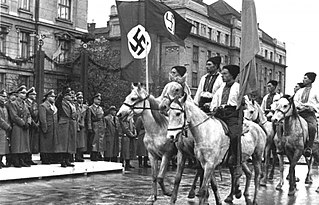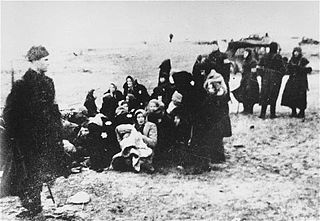
Roman-Taras Yosypovych Shukhevych was a Ukrainian nationalist and a military leader of the nationalist Ukrainian Insurgent Army (UPA), which during the Second World War fought against the Soviet Union and to a lesser extent against the Nazi Germany for Ukrainian independence. He collaborated with the Nazis from February 1941 to December 1942 as commanding officer of the Nachtigall Battalion in early 1941, and as a Hauptmann of the German Schutzmannschaft 201 auxiliary police battalion in late 1941 and 1942.

The 14th Waffen Grenadier Division of the SS , commonly referred to as the Galicia Division, was a World War II infantry division of the Waffen-SS, the military wing of the German Nazi Party, made up predominantly of volunteers with a Ukrainian ethnic background from the area of Galicia, later also with some Slovaks.

The German invasion of the Soviet Union started on 22 June 1941 and led to a German military occupation of Byelorussia until it was fully liberated in August 1944 as a result of Operation Bagration. The western parts of Byelorussia became part of the Reichskommissariat Ostland in 1941, and in 1943, the German authorities allowed local collaborators to set up a regional government, the Belarusian Central Rada, that lasted until the Soviets reestablished control over the region. Altogether, more than two million people were killed in Belarus during the three years of Nazi occupation, around a quarter of the region's population, or even as high as three million killed or thirty percent of the population, including 500,000 to 550,000 Jews as part of the Holocaust in Belarus.
Khatyn was a village of 26 houses and 157 inhabitants in Belarus, in Lahoysk Raion, Minsk Region, 50 km away from Minsk. On 22 March 1943, almost the entire population of the village was massacred by the Schutzmannschaft Battalion 118 in retaliation for an attack on German troops by Soviet partisans.

The Schutzmannschaft, or Auxiliary Police was the collaborationist auxiliary police of native policemen serving in those areas of the Soviet Union and the Baltic states occupied by Nazi Germany during World War II. Heinrich Himmler, head of the SS, established the Schutzmannschaft on 25 July 1941, and subordinated it to the Order Police. By the end of 1941, some 45,000 men served in Schutzmannschaft units, about half of them in the battalions. During 1942, Schutzmannschaften expanded to an estimated 300,000 men, with battalions accounting for about a third, or less than one half of the local force. Everywhere, local police far outnumbered the equivalent German personnel several times; in most places, the ratio of Germans to natives was about 1-to-10.

Ukrainian collaboration with Nazi Germany took place during the occupation of Poland and the Ukrainian SSR, USSR, by Nazi Germany during the Second World War.

The 30th Waffen Grenadier Division of the SS(1st Belarusian), originally called the 30th Waffen Grenadier Division of the SS , was a short-lived German Waffen-SS infantry division formed largely from Belarusian, Russian, Polish, and Ukrainian personnel of the Schutzmannschaft-Brigade Siegling in August 1944 at Warsaw in the General Government.

The Dzyatlava Ghetto, Zdzięcioł Ghetto, or Zhetel Ghetto was a Nazi ghetto in the town of Dzyatlava, Western Belarus during World War II. After several months of Nazi ad-hoc persecution that began after the launch of Operation Barbarossa, the invasion of the Soviet Union, the new German authorities officially created a ghetto for all local Jews on 22 February 1942. Prior to 1939, the town (Zdzięcioł) was part of Nowogródek Voivodeship of the Second Polish Republic.
The Holocaust in Belarus refers to the systematic extermination of Jews living in the Byelorussian Soviet Socialist Republic during its occupation by Nazi Germany in World War II. It is estimated that roughly 800,000 Belarusian Jews were murdered during the Holocaust. However, other estimates place the number of Jews killed between 500,000 and 550,000.

The Ukrainian Auxiliary Police was the official title of the local police formation set up by Nazi Germany during World War II in Eastern Galicia and Reichskommissariat Ukraine, shortly after the German occupation of the Western Ukrainian SSR in Operation Barbarossa.

The Belarusian Auxiliary Police was a German force established in July 1941 in occupied Belarus, staffed by local inhabitants, considered collaborationist. In western Belarus, auxiliary police were formed in the form of Schutzmanchaften units, while in the east they were formed in the form of Ordnungsdienst.

Latvian Auxiliary Police was a paramilitary force created from Latvian volunteers and conscripts by the Nazi German authorities who occupied the country in June/July 1941. It was part of the Schutzmannschaft (Shuma), native police forces organized by the Germans in occupied territories and subordinated to the Order Police. Some units of the Latvian auxiliary police were involved in the Holocaust.

Schutzmannschaft-Brigade Siegling was a Belarusian Auxiliary Police brigade formed by Nazi Germany in July 1944 in East Prussia, from six auxiliary police battalions following the Soviet Operation Bagration.
Estonian Auxiliary Police were Estonian police units that collaborated with the Nazis during World War II.

The Schutzmannschaft Battalion 201 was a World War II Ukrainian Schutzmannschaft auxiliary police battalion formed by Nazi Germany on 21 October 1941, predominantly from the soldiers of Ukrainian Nachtigall Battalion dissolved two months prior and the Roland Battalion. The battalion was part of the Army Group Centre that operated in Belarus.

Volodymyr Katriuk was a Ukrainian-Canadian soldier and beekeeper, who was accused by the Simon Wiesenthal Center of having been an active participant in the Khatyn massacre during World War II. In the annual Nazi War Criminal Report for the years 2012, 2013 and 2014, Katriuk was ranked number three under the list of most-wanted Nazi war criminals as determined by the Simon Wiesenthal Center. Katriuk denied any involvement in war crimes.

The Lithuanian Auxiliary Police was a Schutzmannschaft formation formed during the German occupation of Lithuania between 1941 and 1944, with the first battalions originating from the most reliable freedom fighters, disbanded following the 1941 anti-Soviet Lithuanian June Uprising in 1941. Lithuanian activists hoped that these units would be the basis of a reestablished Lithuanian Army commanded by the Lithuanian Provisional Government. Instead, they were put under the orders of the SS- und Polizeiführer in Lithuania.

Hryhoriy Mykytovych Vasiura was originally a senior lieutenant in the Red Army who was captured during the Nazi invasion of the USSR in 1941 and subsequently volunteered for service in the Schutzmannschaft and the Waffen-SS. Vasiura's wartime activities were not fully revealed until the mid-1980s, when he was convicted as a war criminal by a Soviet military court and executed in 1987 for his role in the Khatyn massacre.
Vasyl Andriyovych Meleshko was a Ukrainian war criminal who participated in the Khatyn massacre.

The Khatyn national state memorial of the Republic of Belarus is the central war memorial of Belarus for all victims of the German occupation during World War II. It commemorates particularly the more than 600 "burnt villages" which, together with their inhabitants, were destroyed by the Germans throughout the war. The Khatyn massacre was one of them; the village lies about 60 kilometres north of Minsk on the road to Vitebsk in the Logoisky district, in the Minsk Region.
















